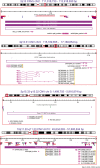Pathogenic rare copy number variants in community-based schizophrenia suggest a potential role for clinical microarrays
- PMID: 23813976
- PMCID: PMC3889806
- DOI: 10.1093/hmg/ddt297
Pathogenic rare copy number variants in community-based schizophrenia suggest a potential role for clinical microarrays
Abstract
Individually rare, large copy number variants (CNVs) contribute to genetic vulnerability for schizophrenia. Unresolved questions remain, however, regarding the anticipated yield of clinical microarray testing in schizophrenia. Using high-resolution genome-wide microarrays and rigorous methods, we investigated rare CNVs in a prospectively recruited community-based cohort of 459 unrelated adults with schizophrenia and estimated the minimum prevalence of clinically significant CNVs that would be detectable on a clinical microarray. A blinded review by two independent clinical cytogenetic laboratory directors of all large (>500 kb) rare CNVs in cases and well-matched controls showed that those deemed to be clinically significant were highly enriched in schizophrenia (16.4-fold increase, P < 0.0001). In a single community catchment area, the prevalence of individuals with these CNVs was 8.1%. Rare 1.7 Mb CNVs at 2q13 were found to be significantly associated with schizophrenia for the first time, compared with the prevalence in 23 838 population-based controls (42.9-fold increase, P = 0.0002). Additional novel findings that will facilitate the future clinical interpretation of smaller CNVs in schizophrenia include: (i) a greater proportion of individuals with two or more rare exonic CNVs >10 kb in size (1.5-fold increase, P = 0.0109) in schizophrenia; (ii) the systematic discovery of new candidate genes for schizophrenia; and, (iii) functional gene enrichment mapping highlighting a differential impact in schizophrenia of rare exonic deletions involving diverse functions, including neurodevelopmental and synaptic processes (4.7-fold increase, P = 0.0060). These findings suggest consideration of a potential role for clinical microarray testing in schizophrenia, as is now the suggested standard of care for related developmental disorders like autism.
Figures


References
-
- Cook E.H., Jr., Scherer S.W. Copy-number variations associated with neuropsychiatric conditions. Nature. 2008;455:919–923. - PubMed
Publication types
MeSH terms
Grants and funding
LinkOut - more resources
Full Text Sources
Other Literature Sources
Medical
Miscellaneous

